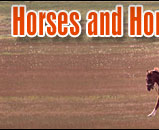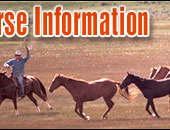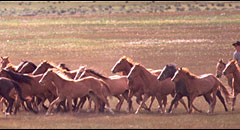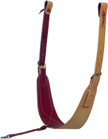 |
   |
|
|
|
You are here: Horses > Horse training > Reining & Cutting Saddle |
The Right Saddle For Reining and Cutting
When choosing a new saddle, it’s easy to become overwhelmed by the choices
available. Few saddles are designed to both ride well and be suitable for
training a performance horse.
|
|
|
While there are specifically designed
“reining” and “cutting” saddles, remember that each design has its own pros and
cons. Also, just because the word “cutting” is on the tag, does not necessarily
mean it was designed well for cutting. This is because saddles are mostly made
by saddle craftsmen, who may or may not be riders. And even saddle makers who
are riders rarely have experience with riding a reining or cutting horse. That’s
why it is important to know what to look for in a good saddle rather than
relying on what’s written on the tag. |
 First, look carefully at the saddle’s seat. A good saddle will allow the rider
to “sit the stop.” The saddle’s seat should lie close to the horse’s back—the
closer, the better. If the seat is more than a couple of inches above the back,
it’s too high. First, look carefully at the saddle’s seat. A good saddle will allow the rider
to “sit the stop.” The saddle’s seat should lie close to the horse’s back—the
closer, the better. If the seat is more than a couple of inches above the back,
it’s too high.
The lowest part of the saddle, also called the pocket, should be in the middle
of the seat. If it’s too far back, the rider will be forced back against the
cantle. Too far forward puts the rider up on the swells.
Finally, make sure the seat is not too small. Riders need a little give to slide
forward and back a little in the seat. Typically, the average woman should get a
16” to 16.5” seat. Men typically require a 16” to 17” seat. If you prefer a
saddle that is built up a little in front to give a more ‘secure-feeling’ ride,
make sure that the pocket is still in the middle.
 Next, take the time to look at the saddle horn and swells. If either is too
high, they will interfere with your ability to rein. For a reining saddle, the
horn should generally be no higher than 3”, and the swells, 7” or less. For a
cutting saddle, swells can be around 8” high. The horn should also be tilted a
little bit forward on a cutting saddle. Next, take the time to look at the saddle horn and swells. If either is too
high, they will interfere with your ability to rein. For a reining saddle, the
horn should generally be no higher than 3”, and the swells, 7” or less. For a
cutting saddle, swells can be around 8” high. The horn should also be tilted a
little bit forward on a cutting saddle.
One of the most overlooked parts of the saddle is also one of the most commonly
overlooked. The stirrup leathers should hang as far forward as possible—ideally,
they should be placed right behind the swells.
The reason for this is simple—balance. When the horse stops and turns hard, the
rider has to sit way down in the saddle to keep balanced. If the stirrup
leathers are hung too far back, the rider’s feet and legs will be behind his
center of gravity and result in poor balance. The rider can even fall forward,
causing the horse to come out of its stop.
Also, look at the material of the leathers. It should be made of thin, flexible
leather. This prevents bulk from impeding the precise leg cues needed for
cutting and reining.
The cantle, or back of the saddle, shouldn’t be tall or steep like a “trail”
saddle. A tall cantle will hit the rider in the back, very uncomfortably.
A cutting or reining saddle should have a full-double rigging, and no
compromises should ever be made on that. Rigging is vitally important. While
some horses might do fine with a 7/8 rigging, you should never buy a saddle with
center-fire rigging. If your saddle has less than the full-double rigging, it
will slide too far forward on your horse’s back as you ride.
This has to do with the natural shape of the horse. The cinch naturally wants to
go around the narrowest part of the horse’s underline—right behind the front
legs. Other rigging styles are made to go around back toward the belly area, and
they can slide forward, taking the saddle too far forward with it.
The rigging Dee should also be in-skirt or dropped 3 to 4 inches below the
swells. This is called a dropped rigging. This lets the tree fit down more
evenly on your horse’s back, is less bulky, and gives you closer contact with
your horse.
Finally, look at the saddle’s tree. Be sure it fits your horse’s back shape. If
the tree is too narrow or wide, your horse will be uncomfortable. Also, ensure a
minimum of an inch of clearance between the withers and the gullet.
Many saddle trees are not curved enough to fit a horse’s back. This is a big
problem to watch out for. If you have a horse that’s slightly sway-backed
wearing a straight saddle, your horse will develop a sore back and strain.
If you are unsure about which saddle to buy, get a good trainer to evaluate its
fit on your horse. The trainer’s opinion could save you and your horse the
problems of an ill-fitting saddle.
|
Read the next horse training article on
Common myths about cutting horses. |
|
|
|
|
 |
|
|
|
|
|
Horse Education
|
|
|
|
|
Horse Information Topics
|
|
|
|
|
|
|
|
Horse Business Owners
|
| |
Advertise with Us
Have your horse products or services exposed to over 27,000 of our monthly visitors.
|
|
|
|
|
|